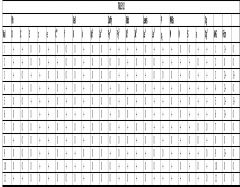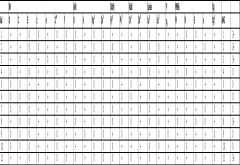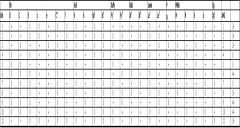![]()
![]()
![]()
Use LEFT and RIGHT arrow keys to navigate between flashcards;
Use UP and DOWN arrow keys to flip the card;
H to show hint;
A reads text to speech;
33 Cards in this Set
- Front
- Back
|
Irradiated blood products are indicated for all of the following conditions EXCEPT:
a. Low birth weight newborns b. In utero exchange transfusion c. Congenital immunodeficiency disorders d. Acquired immunodeficiency (HIV) e. Severe leukopenia patients receiving granulocyte transfusions |
d.
Blood products are irradiated to disable the T cell lymphocytes, which are the major cells causing transfusion-associated graft versus host disease (TAGVHD). Patients who require irradiated blood include low birth weight newborns, infants requiring in utero red cell exchange, congenital immunodeficiency, patients receiving granulocytes transfusions, patients with Hodgkin lymphoma, and patients who are receiving intensive immunosuppressive chemotherapy. There are no reports of TAGVHD in HIV-infected patients. |
|
|
Select the blood product that does NOT require irradiation for a patient on an irradiation restriction:
a. Whole blood b. Red blood cells c. Granulocytes d. Fresh plasma e. Fresh frozen plasma |
e.
All blood products which contain viable lymphocytes need to be irradiated. There are no viable lymphocytes in fresh frozen plasma (FFP). Lymphocytes become nonfunctional when frozen and thawed. However, fresh plasma contains viable cells. |
|
|
The Food and Drug Administration (FDA) requires the periphery of a unit of irradiated blood product receive NOT less than:
a. 50 G b. 35 G c. 20 G d. 15 G e. 10 G |
d.
The FDA requires irradiation exposure to be a minimum of 15 G at the periphery of the irradiated field and 25 G at the center. |
|
|
The time needed for irradiating a unit of blood is:
a. 60 minutes b. 30 minutes c. 20 minutes d. 5 minutes e. Source half-life |
e.
Most of irradiators have a Cesium or Cobalt as a source for irradiation. The intensity and dose of irradiation depends on the half life of the source and not on the time of exposure. Recently intensive X-ray has been used for the source to irradiate the lymphocytes. |
|
|
A pregnant medical technologist is working in the hospital blood bank and an irradiated platelet unit is ordered for a patient with Wiskott Aldrich syndrome. Which one of the
following is correct? a. The pregnant medical technologist is excused from irradiating the blood products. b. The patient with Wiskott Aldrich syndrome does not need an irradiated platelet unit. c. The pregnant medical technologist must wear a lead shield during the irradiation process. d. There is no risk to a pregnant medical technologist during the irradiation process. e. The risk to the pregnant patient varies depending on the irradiation source. |
d.
The irradiation source (cesium) is shielded with lead; any person including pregnant women may use the irradiator. |
|
|
Which of the following associations or agencies is involved in the inspection of a radiation source used in the blood bank?
a. Food and Drug Administration (FDA) b. Nuclear Regulatory Commission (NRC) c. American Association of Blood Banks (AABB) d. FDA and NRC e. AABB, FDA, and NRC |
e.
AABB and FDA are the usual inspection agencies for Blood Banks. Recently Congress passed a bill allowing the NRC the right to inspect the security for any institute use radioactive sources. |
|
|
Which of the following is the correct biochemical moiety that defines blood group A?
a. L-fucose b. N-acetylgalactosamine c. D-galactose d. D-mannose e. N-acetylneuraminic acid |
b.
The ABO antigens are carbohydrate antigen which can be attached to proteins, sphingolipid, or lipid carrier molecules. The basic structure of ABH antigen is a linear oligosaccharide chain composed of three monosaccharides, adding fucose will form H (O) antigens, further adding N-acetylgalactosamine or galactose to form group A or B antigen. So, group A has N-acetylgalactosamine and group B has galactose moiety. |
|
|
The dominant immunoglobulin isotype found in antibodies to the A and B blood group antigens is:
a. IgG b. IgM c. IgA d. IgE e. IgD |
b.
The ABO blood groups are carbohydrate antigens while IgM is the immunoglobin isotype produced as anti-ABO antibody. |
|
|
Hemolytic disease of the newborn due to ABO discrepancy is a milder disorder than Rh (D) incompatibility. The reason is that:
a. The placenta contains ABO antigen, which absorbs the AB antigen. b. The trophoblasts contain a hydrolytic enzyme that destroys the ABO antibody. c. The newborn's red cells have not developed ABO antigen. d. The newborn's plasma contains a neutralizing factor for ABO. e. The ABO antibody cannot cross the placenta/blood barrier. |
e.
ABO antibodies are mostly IgM which do not cross the blood/placenta barrier. |
|
|
Conversion of group A to group O is dependent on which enzyme?
a. Galactosidase b. N-acetylgalactosidase c. Glucosidase d. Neuraminidase e. Trypsin |
b. N-acetylgalactosidase
can split or remove N-acetylgalactosamine from group A antigen and convert A to O antigen. This technique was used to artificially produce O blood type which is then transfused to patients with no side effects. However, preparing this product is not cost-effective for wide use. |
|
|
Which of the following enzyme would convert group B to group O?
a. Galactosidase b. N-acetylgalactosidase c. Glucosidase d. Neuraminidase e. Trypsin |
c. Galactosidase
can break down or remove the galactose from B antigen and convert B to O. |
|
|
Hemolytic transfusion reactions secondary to platelet transfusions are most likely to occur when the donor is:
a. Type A b. Type B c. Type O d. Type AB |
c. Type O plasma
contains anti-A and anti-B antibodies. O plasma with high titer of anti-A and anti-B antibodies can cause hemolytic transfusion reaction (HTR). |
|
|
A patient with blood type A2, Rh negative needs two units of red cells; O Rh negative inventory is critically low. Select the most appropriate action.
a. Type all A red cells for A2 phenotype. b. Call the blood center to obtain two units of A2 blood. c. Titrate the level of anti A in the patient's serum. d. Call the patient's physician and explain the possibility of major hemolytic transfusion reaction if patient is receiving A1 red cells. e. Crossmatch and release two units of A1 red cells. |
e.
Patients with type A2 may have low level of clinically insignificant anti-A antibody. A2 type patient may receive either A1 or O red cells. |
|
|
A 47-year-old female patient complained of weakness and confusion for four days. Her husband also noticed red spots on her arms. The laboratory data showed: hemoglobin 9 gm/dl,
hematocrit 28%, platelets 25!109/L, PT 14 seconds (N 12-16), APTT 28 (N 24-36). What other analyte would be expected to be significantly elevated? a. Total protein b. White cell count c. Lactate dehydrogenase (LDH) d. Antiplatelet antibodies e. Factor VII |
c.
This is a case of micro angiopathy hemolytic anemia (thrombotic thrombocytopenic purpura [TTP]) which causes destruction of red cells. Lactate dehydrogenase (LD) is usually elevated in any destruction process in the body. |
|
|
A 47-year-old female patient complained of weakness and confusion for four days. Her husband also noticed red spots on her arms. The laboratory data showed: hemoglobin 9 gm/dl,hematocrit 28%, platelets 25x109/L, PT 14 seconds (N 12-16), APTT 28 (N 24-36).
Additional laboratory data revealed: LD 1400 IU (N 175-225), creatinine 2.7 mg/dl (N 0.8-1.7), BUN 53 mg/dl (N 24-35). The patient's vital signs are also normal. What is your preliminary diagnosis? a. Disseminated intravascular coagulopathy (DIC) b. Thrombotic thrombocytopenic purpura (TTP) c. Valvular obstruction d. Idiopathic thrombocytopenic purpura (ITP) e. Toxicity with herbal medications |
b.
There are many causes that could cause thrombocytopenia accompanied with low hemoglobin and normal coagulation. Although TTP is the key disorder in the differential diagnosis, malignant hypertension must also be included. With normal blood pressure and normal coagulation, TTP is the most logical diagnosis. |
|
|
A 47-year-old female patient complained of weakness and confusion for four days. Her husband also noticed red spots on her arms. The laboratory data showed: hemoglobin 9 gm/dl, hematocrit 28%, platelets 25x109/L, PT 14 seconds (N 12-16), APTT 28 (N 24-36).The transfusion medicine physician advised her physician to do plasmapheresis. Which of the following statements concerning the use of plasmapheresis is correct?
a. It removes fragment red cells. b. It increases high molecular weight von Willebrand factor. c. It removes platelet antibodies. d. It removes high molecular weight von Willebrand factor. e. Plasmapheresis will stabilize the hypertension. |
d.
In TTP, the main pathology is the presence of high molecular weight (MW) von Willebrand factor (vWF) with formation of microthrombi. The apheresis will remove the high MW vWF and in more than 50% of patients will remove the ADAMTS13 inhibitors (autoantibodies). |
|
|
A 47-year-old female patient complained of weakness and confusion for four days. Her husband also noticed red spots on her arms. The laboratory data showed: hemoglobin 9 gm/dl, hematocrit 28%, platelets 25x109/L, PT 14 seconds (N 12-16), APTT 28 (N 24-36). The most appropriate replacement fluid for plasmapheresis in this patient is:
a. Saline 0.85% b. 2% sodium citrate c. Lactated Ringer solution d. Fresh frozen plasma e. 5% human serum albumin |
d. Plasma
is the preferred replacement fluid in TTP with dual functions; pheresis removes high MW vWF, removes ADAMTS13 inhibitor, and increases ADAMTS13 level. |
|
|
A 47-year-old female patient complained of weakness and confusion for four days. Her husband also noticed red spots on her arms. The laboratory data showed: hemoglobin 9 gm/dl, hematocrit 28%, platelets 25x109/L, PT 14 seconds (N 12-16), APTT 28 (N 24-36).During the apheresis procedure, the patient complained of tingling of her lips. What is the possible cause of this symptom?
a. Fluid overload b. Splenic sequestration of platelets c. Decreased ionized calcium d. Decreased potassium ions e. Increased sodium ions |
c.
These symptoms are due to citrate toxicity secondary to decrease in ionized calcium. |
|
|
A 47-year-old female patient complained of weakness and confusion for four days. Her husband also noticed red spots on her arms. The laboratory data showed: hemoglobin 9 gm/dl,
hematocrit 28%, platelets 25x109/L, PT 14 seconds (N 12-16), APTT 28 (N 24-36).How would you treat this symptom? a. Terminate the procedure. b. Assure patient and do nothing. c. Administer KCl. d. Administer NaCl. e. Administer Ca gluconate. |
e. Calcium gluconate
may be given; the best route is intravenously. Oral calcium salt is acceptable but not effective in many patients. |
|
|
A 47-year-old female patient complained of weakness and confusion for four days. Her husband also noticed red spots on her arms. The laboratory data showed: hemoglobin 9 gm/dl,
hematocrit 28%, platelets 25x109/L, PT 14 seconds (N 12-16), APTT 28 (N 24-36).During the plasmapheresis, the patient received 5% albumin. The patient's blood pressure dropped from 130/85 to 70/35, with facial flushing and extreme anxiety. What is the possible cause of this drop in blood pressure? a. Hypoglycemia b. Treatment with a beta blocker c. Hypothyroidism d. Treatment with an angiotensin-converting enzyme (ACE) inhibitor e. Internal bleeding |
d.
Angiotensin-converting enzyme inhibitor may interact with the polymers of the plastic bags and activate the kallikrein system and produce severe hypotension. |
|

Which red cell antibody is destroyed after treatment with ficin (Table 15.2)?
a. Anti-Fya b. Anti-JKb c. Anti-c d. Anti-N e. Anti-E |
a.
Two antibodies are not ruled out: anti-Fya and E antibodies. Ficin destroyed Fya and enhance E antigens in the testing panel. |
|

Which of the antibodies identified on this panel (Table 15.1) could be a potential cause for hemolytic disease of the newborn?
a. Anti-Lewisa b. Anti-D c. Anti-Kell d. Anti-E e. Anti-N |
b.
The antibody is anti-D. |
|

Prenatal testing on a woman at 20 weeks of gestation shows she is type group O, Rh positive, and her antibody screen is positive. What is the best interpretation of the
antibody patient's panel (Table 15.3)? a. Anti-D, anti-Kell, anti-Lea b. Anti-K, anti-Lea, anti-s c. Anti-K, anti-Lea, anti-E d. Anti-E, anti-K, and anti-Lea e. Anti-N, anti-K, and anti-Lea |
a.
Anti-D, K, and Lea antibodies are not excluded. |
|
|
A patient with sickle cell disease is found to have a U antibody against high frequency antigen U. Which blood donor ethnicity will have U negative blood?
a. Blacks b. Whites c. Asians d. American Indians e. Arabs |
a.
U antigen is a high-frequency red cell antigen and is present in 100% of all ethnic populations and in 99% of black ethnicity. |
|
|
Provision of CMV “safe” products for indicated patients can be accomplished by:
a. First generation leukodepletion filter b. 120 micron filter c. Third generation leukodepletion filter d. Irradiation at 2500 cgy e. Irradiation at 5000 cgy |
c.
CMV safe products require a third generation leukodepletion filter. The third generation filter may reduce the number of leukocytes in red cells or platelet components to less than 5x105, a level that reduces the risk of the transmission of cytomegalovirus as well as HLA alloimmunization. |
|
|
Which of the following is LEAST likely to result in platelet refractoriness?
a. Fever b. Splenomegaly c. Amphotericin use d. Cephalosporin use e. Cyclosporin use |
d.
The least likely cause of platelet refractoriness is cephalosporin use. Others causes may suppress bone marrow platelet production or increase the peripheral destruction. |
|
|
Which product is LEAST likely to require crossmatch?
a. Red blood cells b. Fresh frozen plasma c. Granulocyte concentrate d. A pheresis platelet e. Platelet concentrate pool |
b.
Fresh frozen plasma does not usually require crossmatch. If more than 2 mL of red cells are present in a platelet unit or granulocytes, crossmatching is required. |
|
|
Platelet refractoriness is best defined by performing which of the following?
a. Corrected Count Increment (CCI) b. Post Platelet Recovery (PPR) c. Platelet Surface Denisty (PSD) d. Corrected Platelet Increment (CPI) e. Percent Reactive Antibody (PRA) |
a.
The Corrected Count Increment (CCI) will assist in defining platelet alloimmunization versus consumption. The other tests are not helpful for this purpose. |
|
|
A patient with relapsed acute lymphoblastic leukemia (ALL) has been found to be platelet-refractory following multiple platelet transfusions. Which of the following is the
proper technique to obtain proper platelet unit? a. Perform platelet antigen phenotype b. Perform platelet crossmatch c. Perform autoimmune assay panel, including ANA, anti-DNA d. Request HPA1 negative platelets e. Request ABO matched platelets |
b. Platelet crossmatch
is the appropriate test to obtain platelets for this patient. |
|
|
An international sales person who has spent a month in London every year since 1985 is a regular United
Kingdom blood donor. He volunteers to donate blood in the United States. Which of the following statements is correct? a. Since he donated in UK, he can donate in Manhattan. b. The donor has to wait eight weeks after his London donation before donating in the United States. c. The donor can donate only platelets in the United States. d. The donor will be permanently deferred from blood donation in the United States. e. The donor will be permanently deferred from blood donation in both the United States and the United Kingdom. |
d.
According to FDA guideline, a donor who spends more than three months cumulative period in the United Kingdom is permanently deferred in the United States. |
|
|
What is the percentage of African American patients who may develop anti-U alloantibody after a transfusion?
a. 5% b. 8% c. 4% d. 0% e. 1% |
e.
U antigen is high-frequency antigen with 100% presence rate in whites and about 99% in black populations. In heavily transfused sickle cell patients, U negative patients may develop anti U. |
|
|
Which of the following is true about the Lewis system?
a. Lewis system is intrinsic to red cells. b. Lewis antigens are sensitive to trypsin. c. Lewis B antigens is a product of two gene actions. d. Anti-Lewis A and B are produced in Le (a-b-) recipients post transfusion. e. Anti-Lewis causes neonatal hemolytic transfusion reaction. |
c.
Individuals possessing Le and Se genes will have red cells that express Leb but not Lea. The Lewis antigens are not intrinsic to red cells but are expressed on glycosphingolipid type I chains, adsorbed from plasma onto red cells. Lewis antigens are oligosaccharides and trypsin has no effect on them. Anti-Lewis antibody does not cause neonatal or fetal hemolytic reaction due its inability to cross the placenta and its absence at birth. |
|
|
All of the following statements regarding paroxysmal cold hemoglobinuria (PCH) are correct EXCEPT:
a. It is acute transient condition secondary to viral infections. b. Occurs in children. c. The antibody in PCH is IgM. d. PCH diseases are most frequently positive for anti-P. e. The antibody is a biphasic hemolysin. |
c.
The autoantibody in PCH is IgG and in most cases is anti-P . It reacts with red cells in colder areas of the body causing irreversible complement (C3 or C4) binding which then dissociates from red cells at warmer body temperature. |

